中西文化差异与翻译
- 格式:docx
- 大小:28.83 KB
- 文档页数:4
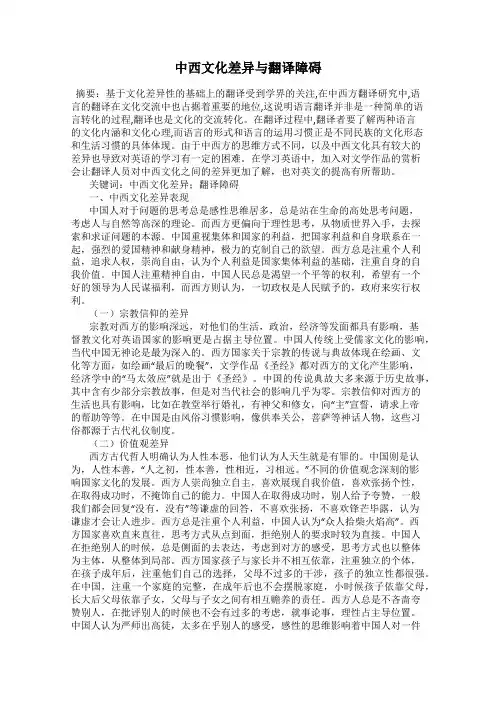
中西文化差异与翻译障碍摘要:基于文化差异性的基础上的翻译受到学界的关注,在中西方翻译研究中,语言的翻译在文化交流中也占据着重要的地位,这说明语言翻译并非是一种简单的语言转化的过程,翻译也是文化的交流转化。
在翻译过程中,翻译者要了解两种语言的文化内涵和文化心理,而语言的形式和语言的运用习惯正是不同民族的文化形态和生活习惯的具体体现。
由于中西方的思维方式不同,以及中西文化具有较大的差异也导致对英语的学习有一定的困难。
在学习英语中,加入对文学作品的赏析会让翻译人员对中西文化之间的差异更加了解,也对英文的提高有所帮助。
关键词:中西文化差异;翻译障碍一、中西文化差异表现中国人对于问题的思考总是感性思维居多,总是站在生命的高处思考问题,考虑人与自然等高深的理论。
而西方更偏向于理性思考,从物质世界入手,去探索和求证问题的本源。
中国重视集体和国家的利益,把国家利益和自身联系在一起,强烈的爱国精神和献身精神,极力的克制自己的欲望。
西方总是注重个人利益,追求人权,崇尚自由,认为个人利益是国家集体利益的基础,注重自身的自我价值。
中国人注重精神自由,中国人民总是渴望一个平等的权利,希望有一个好的领导为人民谋福利,而西方则认为,一切政权是人民赋予的,政府来实行权利。
(一)宗教信仰的差异宗教对西方的影响深远,对他们的生活,政治,经济等发面都具有影响,基督教文化对英语国家的影响更是占据主导位置。
中国人传统上受儒家文化的影响,当代中国无神论是最为深入的。
西方国家关于宗教的传说与典故体现在绘画、文化等方面,如绘画“最后的晚餐”,文学作品《圣经》都对西方的文化产生影响,经济学中的“马太效应”就是出于《圣经》。
中国的传说典故大多来源于历史故事,其中含有少部分宗教故事,但是对当代社会的影响几乎为零。
宗教信仰对西方的生活也具有影响,比如在教堂举行婚礼,有神父和修女,向“主”宣誓,请求上帝的帮助等等。
在中国是由风俗习惯影响,像供奉关公,菩萨等神话人物,这些习俗都源于古代礼仪制度。
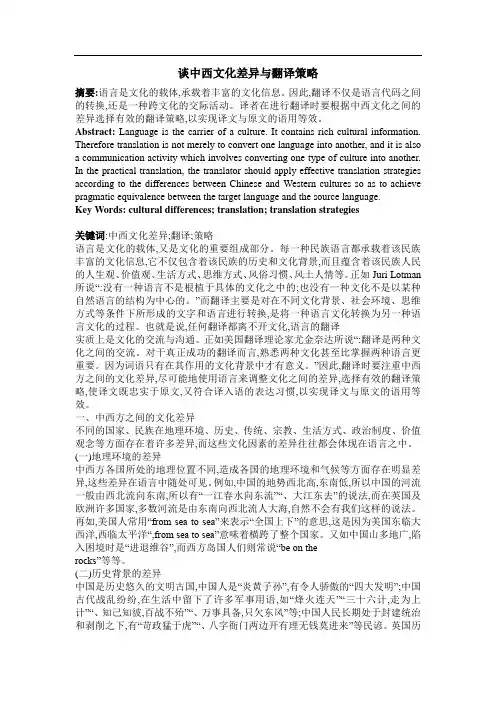
谈中西文化差异与翻译策略摘要:语言是文化的载体,承载着丰富的文化信息。
因此,翻译不仅是语言代码之间的转换,还是一种跨文化的交际活动。
译者在进行翻译时要根据中西文化之间的差异选择有效的翻译策略,以实现译文与原文的语用等效。
Abstract: Language is the carrier of a culture. It contains rich cultural information. Therefore translation is not merely to convert one language into another, and it is also a communication activity which involves converting one type of culture into another. In the practical translation, the translator should apply effective translation strategies according to the differences between Chinese and Western cultures so as to achieve pragmatic equivalence between the target language and the source language.Key Words: cultural differences; translation; translation strategies关键词:中西文化差异;翻译;策略语言是文化的载体,又是文化的重要组成部分。
每一种民族语言都承载着该民族丰富的文化信息,它不仅包含着该民族的历史和文化背景,而且蕴含着该民族人民的人生观、价值观、生活方式、思维方式、风俗习惯、风土人情等。
正如Juri Lotman 所说“:没有一种语言不是根植于具体的文化之中的;也没有一种文化不是以某种自然语言的结构为中心的。

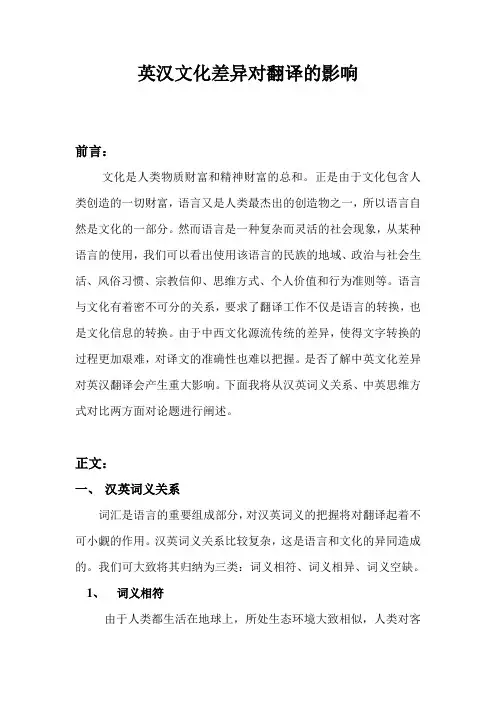
英汉文化差异对翻译的影响前言:文化是人类物质财富和精神财富的总和。
正是由于文化包含人类创造的一切财富,语言又是人类最杰出的创造物之一,所以语言自然是文化的一部分。
然而语言是一种复杂而灵活的社会现象,从某种语言的使用,我们可以看出使用该语言的民族的地域、政治与社会生活、风俗习惯、宗教信仰、思维方式、个人价值和行为准则等。
语言与文化有着密不可分的关系,要求了翻译工作不仅是语言的转换,也是文化信息的转换。
由于中西文化源流传统的差异,使得文字转换的过程更加艰难,对译文的准确性也难以把握。
是否了解中英文化差异对英汉翻译会产生重大影响。
下面我将从汉英词义关系、中英思维方式对比两方面对论题进行阐述。
正文:一、汉英词义关系词汇是语言的重要组成部分,对汉英词义的把握将对翻译起着不可小觑的作用。
汉英词义关系比较复杂,这是语言和文化的异同造成的。
我们可大致将其归纳为三类:词义相符、词义相异、词义空缺。
1、词义相符由于人类都生活在地球上,所处生态环境大致相似,人类对客观世界的认知、人类的大脑结构大致相同,不同社会、不同文化之间必然存在词义相符的关系。
因此,对于词义相符的译文翻译,我们常常选择直译法。
它既可使译文简洁明快,又能保留汉语文化词语的原汁原味。
例如:例文中将京剧脸谱的“红脸”“黑脸”“白脸”直接翻译为:‘red face’‘black face’‘white face’。
2、词义相异词义相异有两种情况。
第一种是指称意义相符,蕴涵意译相异。
汉语有些词所含的文化信息丰富多彩,体现了民族的特色。
如:松、梅、竹在汉文化中称为“岁寒三友”,人们赞誉它们不畏严寒、在风雪中傲然挺立的品德,然而pine trees/plum blossoms/bamboo却不能引起英美人这样的联想,也就是说,这三个词在英语中不具备松、梅、竹在汉文化中的蕴涵意义。
第二种情况是指称意义和蕴涵意译相异。
如:例文中“花脸”和“丑角”的翻译。
“花脸”大多是扮演性格、品质或相貌上有些特异的男性人物,化妆用脸谱,音色洪亮,风格粗犷,作者将其意译为‘male character’。
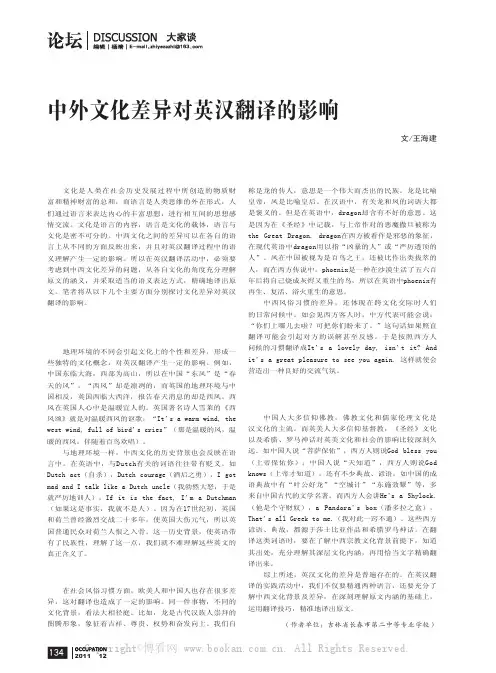
OCCUPATION2011 12134中外文化差异对英汉翻译的影响文/王海建文化是人类在社会历史发展过程中所创造的物质财富和精神财富的总和,而语言是人类思维的外在形式,人们通过语言来表达内心的丰富思想,进行相互间的思想感情交流。
文化是语言的内容,语言是文化的载体,语言与文化是密不可分的。
中西文化之间的差异可以在各自的语言上从不同的方面反映出来,并且对英汉翻译过程中的语义理解产生一定的影响。
所以在英汉翻译活动中,必须要考虑到中西文化差异的问题,从各自文化的角度充分理解原文的涵义,并采取适当的语义表达方式,精确地译出原文。
笔者将从以下几个主要方面分别探讨文化差异对英汉翻译的影响。
一、地理环境、历史背景差异对英汉翻译的影响地理环境的不同会引起文化上的个性和差异,形成一些独特的文化概念,对英汉翻译产生一定的影响。
例如,中国东临大海,西部为高山,所以在中国“东风”是“春天的风”,“西风”却是凛冽的,而英国的地理环境与中国相反,英国西临大西洋,报告春天消息的却是西风。
西风在英国人心中是温暖宜人的。
英国著名诗人雪莱的《西风颂》就是对温暖西风的讴歌:“It’s a warm wind, thewest wind, full of bird’s cries”(那是温暖的风,温暖的西风,伴随着百鸟欢唱)。
与地理环境一样,中西文化的历史背景也会反映在语言中。
在英语中,与Dutch有关的词语往往带有贬义。
如Dutch act(自杀),Dutch courage(酒后之勇),I gotmad and I talk like a Dutch uncle(我勃然大怒,于是就严厉地训人),If it is the fact, I’m a Dutchman(如果这是事实,我就不是人)。
因为在17世纪初,英国和荷兰曾经激烈交战二十多年,使英国大伤元气,所以英国普通民众对荷兰人恨之入骨。
这一历史背景,使英语带有了民族性,理解了这一点,我们就不难理解这些英文的真正含义了。
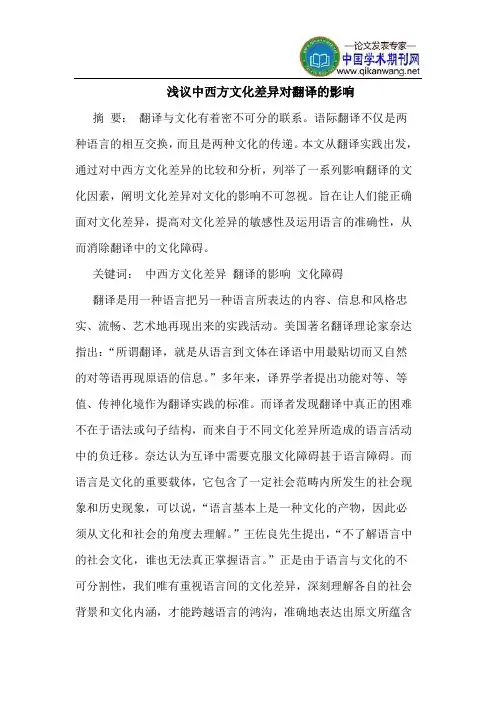
浅议中西方文化差异对翻译的影响摘要:翻译与文化有着密不可分的联系。
语际翻译不仅是两种语言的相互交换,而且是两种文化的传递。
本文从翻译实践出发,通过对中西方文化差异的比较和分析,列举了一系列影响翻译的文化因素,阐明文化差异对文化的影响不可忽视。
旨在让人们能正确面对文化差异,提高对文化差异的敏感性及运用语言的准确性,从而消除翻译中的文化障碍。
关键词:中西方文化差异翻译的影响文化障碍翻译是用一种语言把另一种语言所表达的内容、信息和风格忠实、流畅、艺术地再现出来的实践活动。
美国著名翻译理论家奈达指出:“所谓翻译,就是从语言到文体在译语中用最贴切而又自然的对等语再现原语的信息。
”多年来,译界学者提出功能对等、等值、传神化境作为翻译实践的标准。
而译者发现翻译中真正的困难不在于语法或句子结构,而来自于不同文化差异所造成的语言活动中的负迁移。
奈达认为互译中需要克服文化障碍甚于语言障碍。
而语言是文化的重要载体,它包含了一定社会范畴内所发生的社会现象和历史现象,可以说,“语言基本上是一种文化的产物,因此必须从文化和社会的角度去理解。
”王佐良先生提出,“不了解语言中的社会文化,谁也无法真正掌握语言。
”正是由于语言与文化的不可分割性,我们唯有重视语言间的文化差异,深刻理解各自的社会背景和文化内涵,才能跨越语言的鸿沟,准确地表达出原文所蕴含的思想和涵义。
本文从以下四个方面对文化差异进行对比、分析。
1.生存环境的差异生存环境是指一个民族所处的地理环境和生活条件,它对这个民族的语言及词语的内涵意义有深远的影响。
最典型的例子莫过于汉语中的“东风”和英语中的“east wind”。
中国东临大海,在中国文化中,“东风”象征“春天”、“温暖”,固有“东风报春”之说。
而英国面临大西洋,东临欧洲大陆,属西半球的海洋性气候,从欧洲大陆北部吹来的东风象征着“寒冷”、“令人不愉快”,不过英国人很喜欢报告春天消息的“西风”,正如中国人对“东风”的偏爱。

英汉的文化差异及翻译外国文学最难了解和翻译的第一是联想的意义,接下来,小编给大家准备了英汉的文化差异及翻译,欢迎大家参考与借鉴。
英汉的文化差异及翻译一、英汉习语中所反映的文化差异朱光潜先生在《谈翻译》一文中说:"外国文学最难了解和翻译的第一是联想的意义……","它带有特殊的情感氛围,甚深广而微妙,在字典中无从找出,对文学却极要紧。
如果我们不熟悉一国的人情风俗和文化历史背景,对于文字的这种意义就茫然,尤其是在翻译时这种字义最不易应付。
"英国文化人类学家爱德华·泰勒在《原始文化》(1871)一书中,首次把文化作为一个概念提了出来,并表述为:"文化是一种复杂,它包括知识、信仰、艺术、道德、法律、风俗以及其作社会上习得的能力与习惯。
"可见文化的覆盖面很广,它是一个复要的系统。
语言作为文化的一个组成部分,反映一个民族丰富多彩的方化现象。
1、生存环境的差异习语的产生与人们的劳动和生活密切相关。
英国是一个岛国,历史上航海业曾一度领先世界;而汉民族在亚洲大陆生活繁衍,人们的生活离不开土地。
比喻花钱浪费,大手大脚,英语是spend money like water,而汉语是"挥金如土"。
英语中有许多关于船和水的习语,在汉语中没有完全相同的对应习语,如to rest on one's oars(暂时歇一歇),to keep one's head above water(奋力图存),all at sea(不知所措)等等。
在汉语的文化氛围中,"东风"即是"春天的风",夏天常与酷署炎热联系在一起,"赤日炎炎似火烧"、"骄阳似火"是常被用来描述夏天的词语。
而英国地处西半球,北温带,海洋性气候,报告春天消息的却是西风,英国著名诗人雪莱的《西风颂》正是对春的讴歌。
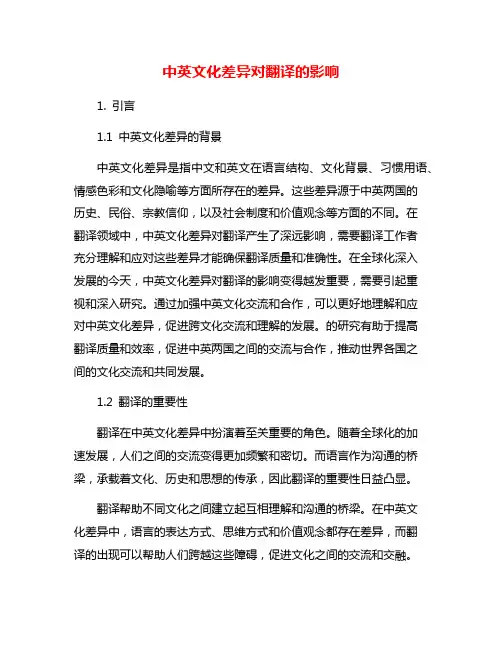
中英文化差异对翻译的影响1. 引言1.1 中英文化差异的背景中英文化差异是指中文和英文在语言结构、文化背景、习惯用语、情感色彩和文化隐喻等方面所存在的差异。
这些差异源于中英两国的历史、民俗、宗教信仰,以及社会制度和价值观念等方面的不同。
在翻译领域中,中英文化差异对翻译产生了深远影响,需要翻译工作者充分理解和应对这些差异才能确保翻译质量和准确性。
在全球化深入发展的今天,中英文化差异对翻译的影响变得越发重要,需要引起重视和深入研究。
通过加强中英文化交流和合作,可以更好地理解和应对中英文化差异,促进跨文化交流和理解的发展。
的研究有助于提高翻译质量和效率,促进中英两国之间的交流与合作,推动世界各国之间的文化交流和共同发展。
1.2 翻译的重要性翻译在中英文化差异中扮演着至关重要的角色。
随着全球化的加速发展,人们之间的交流变得更加频繁和密切。
而语言作为沟通的桥梁,承载着文化、历史和思想的传承,因此翻译的重要性日益凸显。
翻译帮助不同文化之间建立起互相理解和沟通的桥梁。
在中英文化差异中,语言的表达方式、思维方式和价值观念都存在差异,而翻译的出现可以帮助人们跨越这些障碍,促进文化之间的交流和交融。
翻译在促进文化输出和传播方面发挥着重要作用。
很多优秀的文学作品、艺术作品和学术成果只有通过翻译才能被更广泛地传播和理解。
翻译不仅仅是将文字转换成另一种语言,更是在不同文化之间搭建起纽带,让世界各地的人们能够分享到各种不同文化的精华。
翻译在中英文化差异中起着至关重要的作用,不仅仅是简单的语言转换,更是文化交流、思想碰撞和共享的重要工具和手段。
随着全球化的推进,翻译的地位和价值将越来越受到重视。
2. 正文2.1 语言结构差异对翻译的影响语言结构差异对翻译的影响在中英文化差异中起着至关重要的作用。
中文和英文在语法结构上存在许多不同之处,这会直接影响翻译过程中信息的传达和理解。
中文和英文的语序差异会在翻译中带来困难。
中文的语序通常是主谓宾,而英文一般是主语谓语宾语的顺序。

中英习语的文化差异及其翻译方法习语是每个语言都不可或缺的一部分,它们是人们日常交流的重要组成部分,也是语言和文化的体现。
由于中西文化的不同,中英习语之间存在着一些差异。
在进行翻译时,常常会遇到一些难题。
本文将就中英习语的文化差异及其翻译方法进行探讨。
一、中英习语的文化差异中英习语的文化差异主要表现在以下几个方面:1. 文化背景差异:中西方文化背景的差异导致了中英习语的不同。
“一箭双雕”在中国习语中表示一举两得,而在英语中可能用“kill two birds with one stone”来表达同样的意思。
2. 传统习惯差异:中西方的传统习惯也影响着习语的表达方式。
“千里之行,始于足下”这个中国谚语,表达了行动的重要性,而在英语中可能会用“a journey of a thousand miles begins with a single step”来表达同样的观念。
3. 历史文化差异:中国拥有悠久的历史和文化,所以中文中的许多习语都源自古代的故事、典故或者传说。
“不翼而飞”就是一例,它出自《诗经》中的《小雅·鹤鸣》:“鹤鸣于九皋,声闻于野。
非不说子,自有先焉。
不翼而飞,沉水而止。
”而在英语中,由于历史文化不同,习语常常与西方的历史和神话有关。
以上内容表明,中英习语的文化差异存在于语言的表达方式、内涵和源头等方面,这给中英习语的翻译带来了一定的难度。
二、中英习语的翻译方法针对中英习语的文化差异,我们在翻译时需要采取一些对应的方法来保持习语的原汁原味,也要使其容易为目标语言的读者接受。
以下是一些翻译方法:1. 直译法直译法是最常见的中英习语翻译方法,它在尽量保留习语原意的基础上,用目标语言中与之相类似的习语来替换。
中文中的“九牛一毛”在英语中可以直译为“a drop in the bucket”。
2. 动态对等法动态对等法是相对灵活的一种翻译方法,它不是简单地对习语进行翻译,而是根据习语的内涵和文化特色,选用目标语言中更具有表现力和文化内涵的习语。

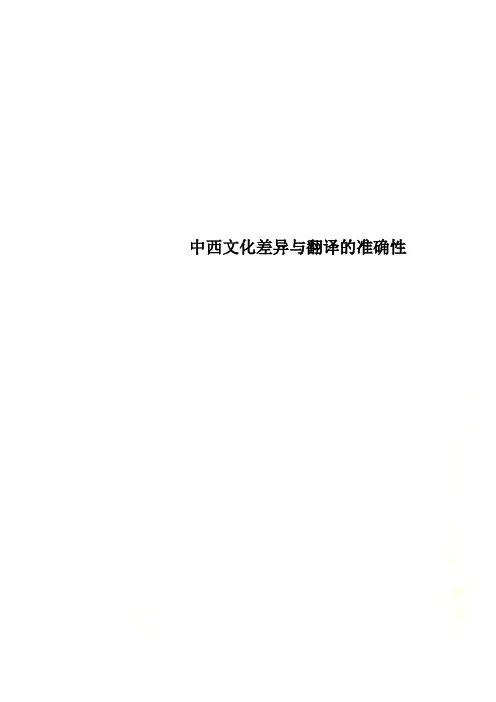
中西文化差异与翻译的准确性“blue films”(黄色影片),“blue software”(黄色软件)等。
而且,英语中的“ yellow boy”不是表示“下流的男孩”,而是“金币”的俗称。
又如,绿色象征万物生长,象征着和平、希望、生机,这在英汉中都是一样的,如:keep the memorygreen(永记不忘),但在英语中green还表示缺乏经验、嫉妒,如green hand(生手),green with envy(十分嫉妒)。
2.动植物文化英汉语中都有着大量的以动植物为喻体的丰富词汇,它们是人类数千年生活经验的总结,语言发达的标志和文明进步的象征。
在翻译时应引起注意。
例如:(4)If he is unhappy with her⋯why doesn’t he leave her? She can be happy without him.It is SOsilly—— this cat—and—dog existence.(T.Dreiser,the Titan)猫狗有时会相互追逐争斗,由此英语短语tO leada cat and dog life含有“像猫狗一样不和,争吵不和的生活”之意,尤其指夫妻之间吵吵闹闹的生活。
了解了这个文化背景,上段话就应该译为:假使他同她在一起并不幸福⋯⋯他为什么不离开她呢?她没有他还可以幸福。
这是多么无聊呀——这种经常吵吵闹闹的生活[s3另外,还有“rain cats and dogs”(下倾盆大雨),“ she is a night owl”(她是夜猫子),“a black sheep”(害群之马)等。
又如,“Jack has fl big mouth and banana.”这句话不可译为“杰克有一张大嘴和一个香蕉”。
在英语中,由于形状相似,banana喻指鹰钩鼻,而用fl sucked orange来比喻“血汗被榨干了的人、被充分利用后不再需要的人。
中西方文化差异对翻译的影响论文中西方文化差异对翻译的影响论文预读: 摘要:中西方的文化差异以及思维模式的差异,必然会给中英文翻译造成一定的影响.要想真正掌握中英文翻译的方法与技巧,不能仅仅限于对英语和中文的字、词、语法表面意义的理解,更重要的是要了解中西方的文化、社会、宗教、历史背景,乃至风俗习惯等多方面的知识.从文化差异出发去研究语言差异,才能有效地把握语言之间的内在联系.本文就中西方文化差异中的思维方式、认知方式以及价值观三个方面的对比,尝试在翻译的过程中以适合的调节手段来化解语言表达上的障碍.一、思维方式的差异对于翻译的影响1、综合型思维与分析型思维差异“综合”,就是事物统一的整体,强调事物的普遍联系,既见部分,又见整体.“分析”,就是把事物的整体分解为许多部分.任何一个民族的思维方式,都是两种方式的结合,都不可能只有分析型思维而无综合型思维,或只有综合型思维而没有分析型思维.由受传统文化的影响,形成了“东方重综合,西方重分析”的思维习惯.体现在语言上的表现是:“中文注重意,英语注重形”.例如:“Thiswasanintelligentlyorganizedandferventmeeti nginapackedTownHall,withMr.StrongintheCh air”.此句的主谓结构为:Thiswasan…meeting…,其他附加成分均围绕这个主句展开,结构十分紧凑,突出了英语里的注重形的特点.如果将其按英语原来的句子结构翻译为“这是一次精心组织的、热情洋溢的、在市政厅里召开的由斯特朗先生主持的会议”.这样译文表面看似忠实于原文,但实际上给人以词藻堆砌,头重脚轻之感,不符合现代汉语的惯,没有给受众一种与读原文同的感觉,也就没有做到对原文的忠实.如果将其按照汉语叙事论理的方式重新安排语序,译为“这是一次精心组织起来的会议,市政厅里济济一堂,热情洋溢,主持会议的是斯特朗先生.”这样的译文,无论从字顺序、层次,表达等各方面才会产生与原文相同的阅读效果.既是地道的汉语,又是对原文语言的忠实.反之,将汉语译成英语时,也要充分尊重英语的形合特点,将汉语的结构译为英语的:以主谓为主干,其他成份分别附着不同的结构中,并形成符合英语语法的译语.2、本体型思维与客体型思维中国文化是:“以人本为主体”,形成了“本体型的思维方式”,即以人为中心来观察、分析、推理和研究事物思维方式.西方文化则是:“以物本为主体”,以自然为本位,较偏重于对自然客体的观察和研究,逐渐形成了“客体型的思维方式”.两种思维方式的差异和不同,表现在汉英—英汉翻译为:(1)中文句子更习惯以人或物为主语,当主语不是明显时就使用无主语句.例如:“跑了和尚,跑不了庙”“Themonkmayrunaway,butthetemplecan’trunwithhim.”(2)英文却相反,习惯以物为主语,除了祈使句外,严格的语法要求是不能出现无主语句.“Thewheatfieldshavenothingtosaytome.Andthatissad.”翻译成“麦田和我不相干,真令人沮丧.”有时为了更符合中国人的思维方式,可以在翻译时,当主语不是很明显时,把原句变成无主语句,然后将被动语态转换成主动语态.如,“Itisnotinhimtobedependeduponintimeofdanger.”译为“危机时刻此人靠不住.”3、螺旋式思维与直线型思维东方人在说话和写文章时,习惯把思想发散出去但还要收回来,最终要落在原来的起点上,回归主题.这样的回转型、曲折型思维导致了汉语的螺旋式思维和螺旋式的文章结构.即,以反复而又发展的螺旋形式对一种问题加以展开,尽量避免直接切入主题,典型的例子有,曾经讲究“起、承、转、合”的八股文章就是这样的布局结构.而西方认为,事物之间是独立的,一切都在向前发展变化.所以直线型思维的人认为,在说话、写文章的时候直接表达优于间接表达,并且要与说话人的立场保持一致,不要用无关的信息掩盖真实的观点.因此英语语篇的内容和结构一般按直线展开,通常包含四个部分:引入、主题、例证、结论,切入主题后就开门见山地先陈述段落的中心思想,即主题句,再分点对主题进行阐述,最后得出结论.在语言表达上表现为:“英语句式结构多为重心在前、头短、尾长.”而“汉语句式结构重心多半在后,头大、尾小.”如:“Imetwithmyhigh-schoolclass-mateattheentranceofthetheatreat7:00yesterdayevening,whomIhadn’tseenfouryears.”应译为:“昨晚7点在剧场门口,我碰到了4年未见面的中学同学.”二、认知方式的差异对翻译的影响在看问题的方面也是存在很大差异,“中国强调从大到小方式去看,而西方强调由小到大的方式”.如,在人的姓名的介绍和书写,以及时间、地址的表达方式上,体现了东西方思维方式中的认知差异.在中国,地址和时间的书写都是从大到小,从整体到局部;而西方文化则正好相反,他们是由小到大的排列.对颜色的认知也可以看出中西方文化的差异,在进行英汉翻译时,也需引起足够的重视.例如:blacktea红茶;blackandblue青一块紫一块;whiteday黄道吉日;white-hairedboy红人;嫉妒的眼红turngreenwithenvy;黄色笑话bluejoke.三、价值观的差异对翻译的影响中国文化,以儒家文化为主,其种族亲属和社会关系表达得十分清楚和严格,不容丝毫的含混和马虎.而西方文化是比较崇尚新教、个体文化价值的,同时也崇尚个人主义,个人至上主义价值观是西方文化的特点这种价值观使得亲属关系就笼统宽松得多.两种不同价值观的文化影响了两种不同的语言,其两种语言在表达上的区别为:例如:“AnEnglishman’shouseishiscastle.(英国人的家是他们的城堡)”,意味着没有理由不可以去无故打扰别人或没有预约不可以贸然拜访某人;“Evenreckoningmakelongfriends(明算账,友谊长);”“Tel lmoneyafteryourownfa-ther(亲父子明算账)”等,这些都表明西方人的个人主义价值观.而受中国文化的以谦虚为美德的价值观的影响,一般会对别人的赞扬、夸奖常礼仪性地予以否认.如“Y ouspeakexcellentEnglish”,中国人常说“no,no”;而西方人崇尚自我奋斗,常会对别人的赞扬乐于接受并表示感谢,积极地回答“Thankyou!”.综上所述,“文化翻译”的确是在“文化研究的大语境”下做翻译,翻译的好要有九份文化,一份语言.了解文化的差异,认识语言的本质,把握其中的客观规律,熟悉文化的异同,才能真正做好翻译工作.S*本文为银川能源学院校级科研课题(2012—KY-P-40)阶段性成果之一参考文献:[1]章和升、王云桥,英汉翻译技巧[M],北京:当代世界出版社,1997.[2]贾玉新,跨文化交际学[M],上海:上海外语教育出版社,1997.[3]连淑能,英汉对比研究[M],北京:高等教育出版社,1993.。
浅谈中西文化差异与翻译随着全球化的推进,中西方文化的交流与碰撞越来越频繁。
由于历史、文化和宗教等方面的差异,中西方文化存在很大的差异。
这种文化差异对翻译产生了很大的影响,因此,本文将探讨中西文化差异的表现、对翻译的影响以及翻译技巧与方法等方面。
中国和西方国家的历史、文化、宗教等方面存在很大的差异。
中国拥有五千年的文明史,儒家思想和佛教、道教文化对中国文化产生了深远的影响。
而西方国家则以基督教、伊斯兰教和犹太教等宗教为主,同时受到古希腊罗马文化、文艺复兴和启蒙运动等思潮的影响。
思维方式:中国文化注重直觉、感性和整体思维,而西方文化则强调逻辑、理性和分析思维。
这种思维方式的不同表现在翻译中,使得中文翻译成英文时,往往更加强调整体性和意群关系,而英文翻译成中文时,则更加注重句子的逻辑性和语法结构。
道德观念:中国文化强调群体和社会的利益,重视忠诚、孝道和家族观念,而西方文化则强调个人权利和自由,注重独立思考和自主决策。
这种道德观念的不同在翻译中可能会造成一些难点,比如在处理具有鲜明道德色彩的词汇时,需要充分考虑目标受众的价值观。
艺术风格:中国传统文化艺术风格独特,如国画、书法、剪纸等,而西方文化艺术则以写实和形式美为主。
这种艺术风格的不同使得中西方文学作品在表现形式和内涵上大相径庭,对翻译者来说,需要充分理解并尊重不同文化艺术风格,尽可能准确地传达原文的意境。
习俗习惯:中西方在生活习惯、节日庆典等方面也存在显著的差异。
例如,中国人过春节、清明节等传统节日时,讲究团圆和祭祖,而西方人则不过这些节日。
这些习俗习惯的不同在翻译中需要有所体现,并需要对目标受众的文化背景和习俗有所了解,以避免产生误解或冒犯。
文化差异对翻译的影响是显而易见的。
在翻译策略上,为了尽可能减少文化冲突和误解,翻译者需要采用一些技巧和方法,如增译、减译、改写等,以适应目标受众的文化背景和语言习惯。
在翻译方法上,直译和意译是两种最基本的翻译方法。
中西文化差异对翻译的影响摘要语言和文化息息相关,紧密相连。
语言与社会文化环境两者相互促进,相互制约。
本文通过举例子详细地分析了中西文化差异对翻译的影响,从而强调了文化差异在翻译中的重要性,让文化差异受到关注与重视,最后也给出了一些文化差异在翻译中的解决方案。
关键词中西文化差异;翻译;影响;解决方案翻译不仅是语言转换的过程,也是文化传播的过程。
在社会生活在中,各个民族的文化可谓是大相径庭。
这就决定了他们在对待某一事物可能会有不能的角度,观点以及评价。
这种不同点就要求我们在进行翻译时,要充分考虑到这种跨文化因素的差异。
巴斯奈特认为:“翻译永远不会在真空里产生,它总是发生在一个连续体中,译者受到各种文本内与文本外制约因素的影响。
”1 中西文化差异对翻译的影响1.1 社会风俗的差异社会风俗是人们自发形成,并为社会大多数人经常重复的行为方式。
对人们行为的控制是非强制性的,是潜移默化的,是特定社会的产物,与社会制度变革有密切关系[1]。
比如,在汉语中“狗”往往带有一种蔑视的感情色彩,像狼心狗肺、偷鸡摸狗、鸡飞狗跳等。
然而在西方国家,“狗”被当成人类最忠实的朋友,人类赋予它的感情一般都是忠实、友好、坚强以及勇敢。
比如“lucky dog”,它的意思“幸运儿”,再如“love me love my dog”译为中文是“爱屋及乌”也就是说“你若把我当朋友,也要把我的朋友当朋友”。
因此,社会风俗的差异是翻译过程需要考虑的一个重要因素。
如果用本国的文化风俗一成不变的翻译他国的文化,必然会造成信息的错误传达。
在翻译过程中,我们要尽量避免错译的现象。
1.2 思维方式的差异不同国家不同民族在思维方式上必定存在差异。
语言受思维方式的控制,因为各民族的思维方式不同,所以各民族的语言表达也会不同[2]。
日本丰田公司有一款名为PRADO的高档车,进入中国市场时,由于这款车性能强、价格高且车的外观设计时髦,车身宽敞,因此这款车被译为“霸道”。
浅析中西方文化差异与英语翻译论文无论是在学习还是在工作中,大家都经常接触到论文吧,通过论文写作可以培养我们独立思考和创新的能力。
相信很多朋友都对写论文感到非常苦恼吧,下面是店铺精心整理的浅析中西方文化差异与英语翻译论文,欢迎大家借鉴与参考,希望对大家有所帮助!浅析中西方文化差异与英语翻译论文篇1摘要:翻译的本质是两种文化的交流。
文化的差异是一个译者必须要处理好的问题,如果处理不当就容易让读者产生歧义。
分析了中西方主要的文化差异,并对主要的差异进行了举例说明。
介绍了对于这种差异的基本翻译方法,它们分别是:异化法、归化法和音译法。
并对这些方法进行了解释。
关键词:文化差异;处理方法;异化法;归化法;音译法1、语言是社会的产物,是人类历史和文化的结晶它凝聚着一个民族世代相传的社会意识,历史文化,风俗习惯等各方面人类社会所有的特征。
不同的文化需要沟通。
沟通离不开翻译,可见文化及其交流是翻译发生的本源,翻译是文化交流的产物。
翻译教学和研究的经验表明:翻译理论和技巧必须建立在不同语言和文化的对比分析的基础上。
翻译之所以困难,归根结底是语言差异和文化差异。
英汉两种语言在表达方式上有相似之处,但2012年02月13日09时09分,《英语学习:英语论文:简析中西方文化差异与英语翻译[1]》由出国英语编辑整理。
2、译法汉语文化中特有的事物在英语文化中完全空缺,这时可采用音译法将具有特殊文化内涵的词语“移植”到英语文化中去。
如:“功夫”kong fu、“乌龙茶”oolong等。
许多采用音译法翻译的词语已成为英语中的外来词,被西方大众广泛接受。
3、结语语言是文化的一部分,也是文化的传承者。
文化依靠语言进行传播、交流。
东西方文化的差异对英汉互译产生了深远的影响。
因此对于译者来说熟悉中英两种文化甚至比掌握这两种语言更为重要。
翻译离不开文化,没有基于文化的翻译是达不到交流的目的的。
本文只列举了三种基本的翻译方法,对于文化意象处理的问题,并没有统一的翻译方法和公式,译者应根据上下文灵活处理。
基于中西文化差异谈英语翻译技巧在如今的全球化时代,跨文化交流变得越来越频繁,因此英语翻译技巧对于有效沟通变得至关重要。
然而,由于中西文化的差异,翻译过程中可能会面临一些困难和挑战。
下面将探讨一些基于中西文化差异的英语翻译技巧。
首先,需要理解中西文化之间存在的价值观和思维模式的差异。
中文注重含蓄和内涵,而英语更注重直接、明确和简洁的表达。
在翻译中,需要根据目标语言的特点和读者的需求对文本进行调整。
例如,对于中文中常见的比喻、成语和谚语,翻译时可能需要进行解释或寻找相似的表达方式。
其次,要避免字面翻译的错误。
中文和英文的语法结构和表达方式有所不同,直译可能导致信息的误解或丢失。
在翻译中应尽量将原文的意思准确传达出来,而不仅仅是逐字逐句的翻译。
为了达到这个目标,译者需要具备深入理解源语言和目标语言的能力,并善于运用各种翻译技巧和方法。
其次,要注意文化背景的细微差异。
每个国家和地区都有自己的文化背景和特点,这些背景会影响人们的思维方式和观念。
在翻译中要考虑到目标读者的文化背景,避免使用会产生误解或不适当的词语和表达方式。
此外,还需要注意一些文化符号和习俗,确保翻译内容的准确性和恰当性。
此外,翻译时还要考虑到不同语言的语音、韵律和语调的差异。
中文和英语在这方面存在明显的不同。
例如,中文中的押韵和平仄在英文中可能无法保留。
为了让译文更贴近原意,译者需要灵活运用英语的表达方式和修辞手法,使译文既符合目标文化的特点,又能准确传达原文的意思。
最后,要不断学习和提高自己的翻译技巧。
翻译是一门艺术,需要不断的实践和学习来提高翻译水平。
通过阅读各种文献、参与翻译项目和和其他翻译人员进行交流,可以不断拓宽自己的知识和视野,提高翻译的准确性和流利度。
总而言之,中西文化差异对于英语翻译来说是一个重要的考虑因素。
译者需要具备良好的跨文化和语言学习能力,灵活运用翻译技巧和方法,以准确和恰当的方式将原文的意思传达给目标读者。
通过不断学习和提高自己的翻译能力,译者可以更好地实现中西文化之间的沟通和理解。
临床2班刘诗韵2013111040中西文化差异与翻译美国著名的翻译理论家尤金奈达认为:翻译是指从语义到语体在译语中间最贴切而又最自然的对等语再现原文的信息。
奈达的定义体现了他在语义和语体两个层面提倡等值翻译的观点, 却未提到文化的再现。
对翻译的正确理解应该是语际之间的信息传递和语族之间的文化交流。
文化、语言和翻译之间关系密切。
英国语言学家约翰莱昂斯认:“特定的社会的语言是这个社会文化的组成部分。
每一种语言在词语上的差异都会反映使用这种语言的社会的事物、风俗以及各种活动在文化方面的重要特征”。
两种不同的民族语言的交流,实质上是两种民族文化的交流。
翻译是一种有目的的跨文化交际行为,任何翻译都离不开文化。
为此,译者不但要精通目的语和源语,还要了解和研究诸多语言背后的文化,熟悉中西文化的差异。
在正确翻译观的指导下,对文化差异进行合理的文化转换。
一、中西文化价值观念的差异价值观念是任何社会或文化中的人不能回避的指令, 作为文化构成的深层因素, 它既是社会文化的组成部分。
又是社会文化在人们心目中长期渗透、积淀的结果。
变成民族性格的基石。
中西文化差异之一是时间取向不同。
中国人在时间上采取过去取向,对过去的眷恋自然而然地产生了中国人对悠久历史和灿烂文化的珍视。
与此相通,中国人崇拜祖宗、敬老尊师、重经验、重年龄。
在中国文化中长者是智慧和权威的象征。
称年长者“老师傅“、“老干部”、“老大爷”。
“马老”、“张老”甚至成了少数德高望重的人才享有的尊称。
与此相反。
西方人在时间上是未来取向。
美国人喜欢向前看, 总是着眼于未来。
因而尊重青年是西方文化中第一级价值。
老在西方意味着来日无多,面临失去。
竞争力而被淘汰的危险。
因此, 我国公共汽车上为敬老而设的专座的字样不能简单地译为“old people“, 应按西方人的观念译为“Courtesy Seats”, 方可被英美人所接受。
英美人忌老、怕老。
他们费尽心机地来委婉地表示“老”这个概念。
如: the adbanced in age( 年长者) , the mature( 成熟者) , the longer liv ing( 生活经历较长者) , a seasoned man( 历练者) , senior cit izens( 资深公民) 等。
谦逊在中西文化中的地位也不同。
受儒家思想的影响, 中国人喜欢谦虚内敛。
所以中国人与人相处,习惯于卑己尊人。
比如在接受别人赞誉时与西方人反应不同,总是说成“做的不够”或“没什么”, 给人的感觉是受之有愧。
于是写文章的标题总爱用浅谈、略论、试论、管见等。
提及自己的作品总爱用拙文、敝作等。
中国人在谈论自己的事情时, 通常表现自谦或自贬, 力图达到“无我”或“超我”的境界。
这种贬抑自我的做法令英美人十分费解。
按照他们的习惯, 听到别人赞扬时应表示感谢或赞同, 这样既是对自我的肯定, 也是对他们鉴赏力的尊重。
鉴于文化的差异, 汉语论文标题中的初、浅、试之类的谦辞,译成英语时可不译, 以避免误解。
相反, 在论及有关对方的事情时, 中国人总爱抬高对方, 也是贬抑自我的一种方式。
汉语中的敬辞很多, 如: 大作、贵府、贵姓、恭候、雅正等。
译成英语时, 可把“敬”含义省去,译出“辞”即可。
如”大名”译成”your name”, ”贵府“译成” Your home“。
若将”大名“译成”your greatname“, ”贵府“译成”your honorable home“, 英美人会认为那是讽刺或挖苦, 或至少是虚伪。
东西方价值观念差异较大的另一方面是个人与集体的关系。
西方文化最重要的观念是个人主义( Individualism) , 其具体表现是自立精神( Self- reliance) 和自我实现( Self- achievement ) 。
翻译 Amer-ican dream实际上要对美国人不依赖世袭的物质条件和社会地位、个人奋斗的精神进行诠释。
另外, 美国人强调人生而平等( all men are created equal) 。
中国传统文化中最重要的价值观念是“忠“、”孝“,是一种以家庭为基本单位强调整体利益和顾全大局的文化。
中国人崇尚”修身、齐家、治国、平天下“及”先天下之忧而忧, 后天下之乐而乐“, 而英美人信奉”Every man for himself, and God for us all“。
汉语说“闲人莫入“, 首先着眼于他人, 英语却说The employees only 首先想到的是自己。
中国人非常注重等级观念。
汉语通常以职务称呼人, 如李科长、张市长等, 以示尊重。
英语里除总统( president ) 、教授( professor ) 、医生( doctor) 等为数不多的头衔用于称呼外, 绝大多数人之间以名字称呼。
由于这种文化差异, 这是陈科长一般不译成: This is sect ion chief Chen, 而译成This is Mr. chen, our section chief。
总之, 价值标准因文化不同而各异。
我们通过英汉民族价值观念的对比研究, 在翻译时力争恰到好处地完成文化对接的任务。
二、民族审美观的差异汉英民族分属于东西两大不同的文化体系。
汉民族特殊的社会历史条件和生活经历在文化深层的沉淀, 反映出汉民族天人合一、重整合、重暗示、重含蓄的人文思想和艺术审美观。
以景物描写为例: 中国人写景强调心境意绪的传达, 以我观物, 故物皆著我之色彩( 王国维) 。
汉语的景物描写大多文笔优美, 用词含蓄, 体现出诗情画意的艺术境界。
“落霞与孤鹜齐飞, 秋水共长天一色”就表现了中国人的审美情趣, “但愿人长久, 千里共婵娟“则表现了一种意境美和情感美。
西方的审美习性在这些方面则大相径庭。
西方的传统哲学强调分析型抽象理性思维, 更多的强调模仿和再现。
亚里士多德主张美学的最高境界是“照事物应有的样子去模仿”, 这一观点早已渗透到西方文学艺术的各个领域。
西方传统的文学艺术历来提倡“模仿自然“, 西方的现实主义、浪漫主义、自然主义等艺术流派的本质都源于模仿论。
反映出西方哲学思维天人各一、重理性、主客观对立的特点。
反映到景物描写的语言上, 就出现英语思维缜密, 用词强调简洁自然、描写突出直观可感的风格。
下面一例翻译可反映汉英两种语言在描写景物时的差异:T iny islande are strung around the edge of the peninsula like a pearl necklace.H unks of coral reef ,coconut p alme and f ine w hite sand .试译: 座座岛屿玲珑小巧, 紧密相连, 像一串珍珠缀成的项链, 环绕着半岛边缘。
岛上珊瑚礁红, 椰林成片, 沙滩如银, 景色如诗如画。
英文读起来就像真实拍下的照片, 全是景物的客观排列, 汉语则多见景生情的自然抒发。
因而在翻译时, 我们一定要注重突出两种民族不同的审美习惯的差异。
三、宗教信仰的差异在西方, 宗教是社会生活和思想文化中极其重要的部分, 渗透到社会生活、风俗习惯和文学艺术等各个方面。
如绘画的第一个高峰发端于拉菲尔米开朗基多的宗教作品, 文学上但丁的“神曲“、米尔顿的”失乐园“、歌德的”浮士德“均取材于宗教。
特别是中世纪的宗教神学几乎主宰了所有的精神领域。
所以说宗教贯穿到西方社会文化的几乎所有的领域。
毫无疑问, 宗教对英语的影响也是十分巨大的。
大量的英语习语、格言、典故词、派生词均来源于”钦定圣经译本“, 成为英语中重要的组成部分。
如: 习语the st ill small voice( 良心的声音) , of the earth earthy( 世俗之至) ; 格言 Hat red st irreth up st rifes,butlove covereth all sins( 恨挑起争端, 爱宽容过错) ; 典故scapegoat ( 替罪羊) 、t hirty pieces of silver( 三十块硬币) 等。
中国人信仰儒教、道教、佛教, 在中国的历史长河中, 三教互补, 甚至合而为一, 共同对中国文化起作用。
他们渗透到中国文化的各个方面, 其影响也自然反映到语言之中。
如: 天下兴亡, 匹夫有责; 苦海无边, 回头是岸; 乐极生悲等。
由于中西宗教信仰的差异, 要求译者要了解两种特定的宗教文化背景, 翻译中切不可望文生义。
英语中有很多词语表达特定的宗教意义。
如: End of the w orld( 世界末日) , 中国人看到这几个字很容易理解为大难临头、人类即将毁灭的恐怖时光。
然而对西方人来说, 它表示伸张正义的时刻, 是指中国人所说的“善有善报, 恶有恶报“之意。
另外, 宗教术语( 作为隐喻) 进入非宗教的语境, 变成日常用语, 是常见现象。
有些字眼有佛经里的术语, 如报应、许愿; 有的是伊斯兰术语, 如施舍; 有的是基督教术语, 如赎罪等。
在翻译中要注意这些词的身世来源, 否则可能翻译不当。
有一本外国人写的介绍儒家思想的书, 引入孔子若干语录, 其中之一为: The man of principle is courageous. He knows the right and w ill f ight for it at all vost s. God is on hisside . 孔子怎么也不会说“God“, 这里应该是误译。
在翻译过程中, 译者切不可硬要将异族文化向本族文化靠拢, 一定要了解宗教文化的差异, 才能准确、娴熟地进行跨文化交际。
四、传统文化观念与文化意象的差异词在特定的语境中具有不同的联想词义, 而传统的文化观念与文化意象则是不同民族文化中约定俗成的认知图示。
如松、竹、梅岁寒三友在中国人心中象征坚韧不拔的优良品质, 而对于西方人来说,只不过是三种普通的值物, 没有特殊的文化涵义。
英汉两个民族因生活环境与生活经历的不同, 在传统的文化观念与文化意象上必然存在差异。
汉语中的“老黄牛、小绵羊“不会给英美人带来任劳任怨和顺从听话的联想, 英语的bear 和lizard 也绝不可能在中国人心中唤起怒气冲冲或油头粉面的形象。
对英国人和大部分西方人来说狮子是百兽之王, 从regal as a lion( 像狮子一样庄严) 、majest ic as a lion( 像狮子一股雄伟) 可以看出狮子在英语里享有很高的声誉。
雪莱就号召压迫者像狮子般醒来( rise like a l-ion) 。
在中国文化里, 人们对老虎才有类似的联想, 虎英勇大胆、健壮有力, 所以有”将门虎子“、“生龙活虎“等词语。
因为众所周知的龙在中西方具有不同的文化意象的原因, 大家熟悉的“亚洲四小龙”被译为“亚洲四虎”( four t igers) 。